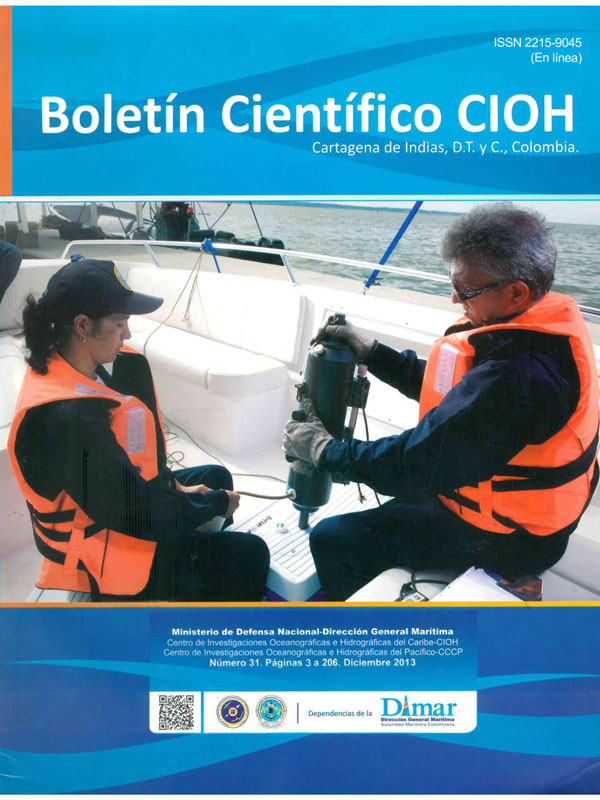Water quality assesment in the Cartagena Bay during the dry season of 2013
DOI:
https://doi.org/10.26640/22159045.256Keywords:
microorganism indicators, water quality, waste waters, nutrientsAbstract
Cartagena Bay is influenced by discharges from Dique Channel and domestic waste water discharges from the city of Cartagena, which together reach a volume of 120,000 m3/day. This paper aimed to assess the current status of water quality of the Bay in relation to the concentration of some water quality indicators (total coliforms, Escherichia coli and Enterococcus sp.). Water samples were taken within three layers of the column (size, middle and bottom) over 14 stations during the first week of March, and were processed by membrane filtration technique. The results were compared with the limits set by the European Economic Community (EEC), the Environmental Protection Agency of the United Kingdom (EPA) and the International Maritime Organization (IMO). The results showed that total coliforms exceeded the limits allowed by the EEC in 13 stations at least one of the water column levels established. In the case of E. coli, 10 stations exceeded the permissible limits EPA and 11 exceeded the limits according to the CEE at least at one level of the water column. The Enterococcus sp. exceeded limits Bosque stations and Sociedad Portuaria, both surface and in the middle of the water column in physicochemical analysis were associated variables (pH, temperature and nutrients) to the survival of microorganisms in the bay faecal.Downloads
References
[2] Cañón, M., Tous, G., López, K., López, R. y Orozco, F. 2007. Variación espaciotemporal de los componentes fisicoquímico, zooplactónico y microbiológico en la Bahía de Cartagena. Bol. Cient. CIOH Nº 25: 120-130.
[3] Alonso, D. P., Pineda, J., Olivero, H., González y N. Campos. 2000. Mercury levels in muscle of two fish species and sediments from the Cartagena Bay and the Cienaga Grande de Santa Marta, Colombia Enviromental Pollution. (109) 157-163.
[4] Tuchkovenko, Y. y Rondón, S. 2002. Estudio del comportamiento de la contaminación de la bahía de Cartagena. Bol. Cient. CIOH Nº 20: 56-67.
[5] Moscarella, García, F. y Palacio, C. 2010. Microbiological water quality of Santa Marta bay, Colombia. Dyna. 78(167) 132-141.
[6] Savichtchevaa, O. y Satoshi, O. 2006. Alternative indicators of fecal polution: Relations with pathogens and conventional indicators, current methodologies for direct pathogen monitoring and future application perspectives. Water Research. Volumen 40, Issue 13, pp 2463-2476.
[7] Vergaray, G., Carmen, R., Méndez, H., Morante, Y., Vidalina, I., Heredia, V. y Béjar, R. 2007. Enterococcus y Escherichia coli como indicadores de contaminación fecal en playas costeras de Lima. Revista del Instituto de Investigaciones FIGMMG, Vol. 10, No 20, 82-86.
[8] Hamzah, A. y Hazwa, S. 2011. Microbiological Study in Coastal Water of Por Dickson, Malaysia. Sais Malaysiana 40(2). 93-99.
[9] Toledo, H., Hernández, C., Rodríguez, C., Bittner, V., Ferreira, L. y Orellana, F. 2005. Estudio de la contaminación fecal mensual y estacional en la zona costera adyacente al emisario submarino en la bahía de Puerto Montt. Gayana 69(1): 104-112.
[10] Cañón, M., Quintana-Saavedra, D.M., Tous, G. y Llamas, J. 2007. Presencia de organismos exógenos y patógenos en aguas de lastre de buques de tráfico internacional. Informe final. Fase V/V. Centro de investigaciones Oceanográficas e Hidrográficas del Caribe (CIOH) (98) 54 pp.
[11] Andrade, C., Thomas, F., Lonin, S., Parra, C., Menanteau, L., Cesaraccio, M., Kunesch, S., Andreau, A., Velasco, S., Piñeres, C. 2004. Aspectos morfodinámicos de la Bahía de Cartagena de Indias. Bol. Cient. CIOH No. 22 90-104.
[12] Tous, G., Castro Mercado, I., Cañón, M., Quintana-Saavedra, D.M. 2007. Panorama de la contaminación del Caribe colombiano. Dirección General Marítima. Cartagena de Indias. Pp 61-8.
[13] Parsons, T.R., Maita, C.M. y Lalli, C.M. 1989. Manual of Chemical and Biological Methods for Seawater Analysis. Primera Edición 1984, reimpreso 1985, 1989. Gran Bretaña. Pp 22-25.
[14] APHA-AWWA-WPCF. 2012. Standard methods for analysis of water and wastewaters. Edicion 22. Editorial Díaz de Santos. Madrid, España. 1150 pp.
[15] Salas, H.J. 2000. Historia y aplicación de normas microbiológicas de calidad de agua en el medio marino. Water Science Technology, Vol. 18, No. 11, 1986. Centro Panamericano de Ingeniería y Ciencias del Ambiente. Organización Mundial de la Salud. Versión Actualizada.
[16] Lonin, S. y Giraldo, L. 1996. Resultados preliminares del estudio de la dinámica del sistema de caños y lagunas de Cartagena. Bol. Cient. CIOH Nº 17: 57-63.
[17] Office of Research and Development Office of Water Regulations Microbiology and Toxicology. Bacteriological Ambient Water Quality Criteria for Marine and Fresh Recreational Waters. U.S. Environmental Protection Agency. January (1986) P. 8.
[18] Hoong, K. y Giek Goh, G.S. 2013. Modeling the effect of light and salinity on viable but non-culturable (VBNC) Enterococcus. Water Research. 47: 3315-3328.
[19] Restrepo I, Franco, D, Correa, I, Escobar, I, Otero, L, y Gutierrez J. 2013. Sedimentos Superficiales de la Bahía de Cartagena. Bahía de Cartagena (Colombia): distribución de sedimentos superficiales y ambientes sedimentarios. Latin American journal of Aquatic Research, 41(1): 99-112.
Downloads
Published
Issue
Section
License
Attribution — You must give appropriate credit, provide a link to the license, and indicate if changes were made. You may do so in any reasonable manner, but not in any way that suggests the licensor endorses you or your use.
NonCommercial — You may not use the material for commercial purposes.
NoDerivatives — If you remix, transform, or build upon the material, you may not distribute the modified material.
No additional restrictions — You may not apply legal terms or technological measures that legally restrict others from doing anything the license permits.



